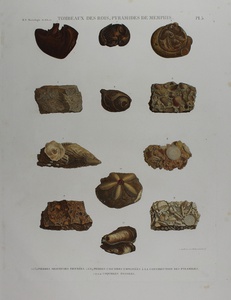| Method | Copper engraving with hand colouring |
| Artist | François Michel de Rozière |
| Published | [Paris, c. 1809] |
| Dimensions | Image 500 x 350, Plate 584 x 430, Sheet 680 x 504 mm |
| Notes |
A finely engraved and detailed plate illustrating various sedimentary, Silica, rock samples and fossilised shells, found in the region of the Tombs of Kings and the Pyramids of Memphis. From François Michel de Rozière's contribution to Napoleon's 'Description de l'Egypte', volume entitled 'Minéralogie, Bords de la mer rouge et vallée de l'égarement, Coquilles fossiles'. Napoleon saw his invasion of Egypt as an opportunity to discover and catalogue the country's wealth of geological and archaeological specimens. He employed 151 savants under the directive 'The Commission of Sciences and Arts', including scholars, mineralogists, archaeologists and geologists. Many of the group were just out of education, and their mission was kept secret until the last moment. They were blindly streamed by foot and coach to southern France, where they boarded ships alongside the soldiers and sailors and set sail for an unknown destination. This deployment of intellectual resources is considered by some as an indication of Napoleon's devotion to the principles of the Enlightenment, and by others as a masterstroke of propaganda obfuscating the true motives of the invasion; the increase of Napoleon's power. Nonetheless, his discoveries in Egypt gave rise to fascination with Ancient Egyptian culture and the birth of Egyptology in Europe. François-Michel de Rozière (1775-1842) was a French mining engineer and mineralogist. Soon after graduating from the School of Mines he was sent as an assistant mineralogist to Egypt, on Napoleon's 1798 scientific expedition. When his superior, Deodat de Dolomieu, became sick and went home after only nine months, the 23 year old Rozière was suddenly bumped up to chief mineralogist. He thus turned his attention to collecting and cataloguing mineral samples from all over Egypt. Upon his return to Paris in 1801, he took charge of writing the volume on minerals for the scientific report on Napoleon's expedition, the 'Description de l'Égypte' (1809-28). Though certainly exemplary, this work is Rozière's only scholarly contribution to science. Condition: Light foxing to right margin, not affecting image. Blindstamp to top right, as issued. |
| Framing | unmounted |
| Price | £200.00 |
| Stock ID | 45207 |

